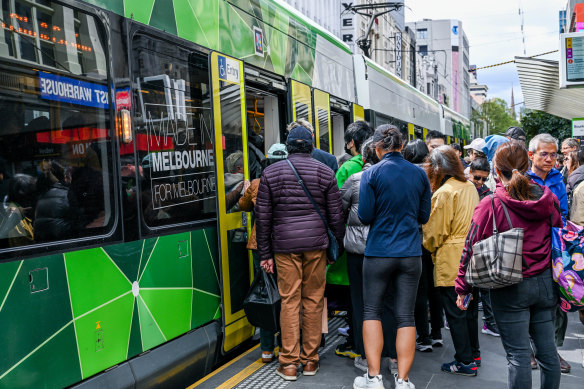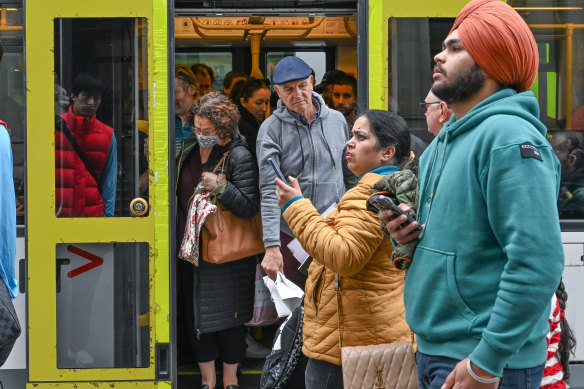This was published 7 months ago
Free tram rides to the MCG, Victoria Market come at a price
A push to expand Melbourne’s free tram zone from the CBD to the inner suburbs and the MCG has revived debate about whether it should be scrapped entirely, as paying commuters get crowded out.
The free zone – which covers the Hoddle Grid, Docklands and as far north as Queen Victoria Market – has cost the state transport department up to $13 million a year to operate since it was introduced in 2015.

Passengers waiting to board a packed tram in the free zone on Friday.Credit: Joe Armao
City of Melbourne Lord Mayor Nick Reece has promised to lobby the state government to expand the zone if he wins another term in council elections next month, saying it would boost the city’s economy, help tourists get around and ease the cost of living.
He also wants it extended to cover stops at the Arts Centre, Melbourne Park, Melbourne Museum, the convention centre, the casino and the University of Melbourne.
Not to be outdone, rival mayoral candidate Arron Wood has promised to deliver an even bigger free tram zone extending to the top of Royal Parade and Flemington Road, through North Melbourne’s Errol Street, and as far as the Domain in South Yarra.
But calls for a bigger free zone are butting up against long-held concerns the scheme has made rush-hour trams and platforms overcrowded, and degraded service for paying customers who need to travel more than a few city blocks.
Former Liberal premier Denis Napthine first proposed the free zone in the lead-up to the 2014 state election. Labor copied the policy and implemented it in 2015.
Public Transport Users Association spokesman Daniel Bowen said the free zone caused too many problems for travellers who wanted to travel from the CBD to the suburbs.
“People do enjoy a free ride, but it does cause a lot of problems with overcrowding and delays,” he said.
“We often see paying tram passengers unable to board because the trams are crowded. It causes more problems than it solves and it should be scrapped.”

“We often see paying tram passengers unable to board because the trams are crowded,” says transport users’ advocate Daniel Bowen.Credit: Joe Armao
Infrastructure Victoria has also called for the free zone to go, citing the effect of overcrowding on passengers who are elderly, disabled or pushing prams.
Amit Chawathe commutes to the CBD from North Melbourne daily and said the problem of overcrowding should be solved with more services, not by ending the free zone.
On Thursday, Chawathe was taking three colleagues visiting from interstate on a free trip up Bourke Street to have lunch. He said it would not have been worth them paying $6 for myki cards and loading them with credit.
“They should extend it. If the free tram zone was there I’d take my colleagues further,” Chawathe said. “Melbourne has this infrastructure, why don’t we use it more?”
Bowen said one key argument in favour of the free zone – the hassle of acquiring a myki – will evaporate when the ticket system is updated to allow travel with just a bankcard or smartphone. Victoria’s new $1.7 billion ticket system is due to start rolling out next year.
A state parliament inquiry in 2019 heard that the number of tram trips taken within the CBD almost doubled when the free zone was introduced, growing from 18.5 million trips a year to 35.5 million.
Yarra Trams told the inquiry that the extra passengers caused “overcrowding on trams in the highest-demand locations”, and the extra time required for them to board and alight was “slowing the system down where reliability and efficient movement is most critical”.
The Department of Transport told the inquiry a “significant” number of commuters could not board afternoon trams because they were filled with free riders who chose to tram short distances instead of walk.
The share of journeys within the CBD taken by tram grew by 5 to 10 per cent when the free zone was introduced. Journeys taken by walking fell by the same amount.
Yarra Trams is reimbursed by the transport department for its estimated share of lost fare revenue from the free CBD trips. Expanding the free zone in the way Reece proposes would increase the cost to government to $28 million per year, it said.
Overall monthly tram patronage is down around 22 per cent since the pandemic and work-from-home revolution.
Monash University public transport researcher Graham Currie said there were real benefits to the free zone, especially for tourism, which had to be balanced with the problems it caused.
“Trams are Victoria’s number-one tourism attraction and they’re great things to get around the city,” Currie said. “It’s a double-edged sword. It’s giving money away and there are operational issues.”
Public transport minister Gabrielle Williams said there were “no plans to extend the free tram zone” but declined to comment on the calls to remove it.
The Morning Edition newsletter is our guide to the day’s most important and interesting stories, analysis and insights. Sign up here.